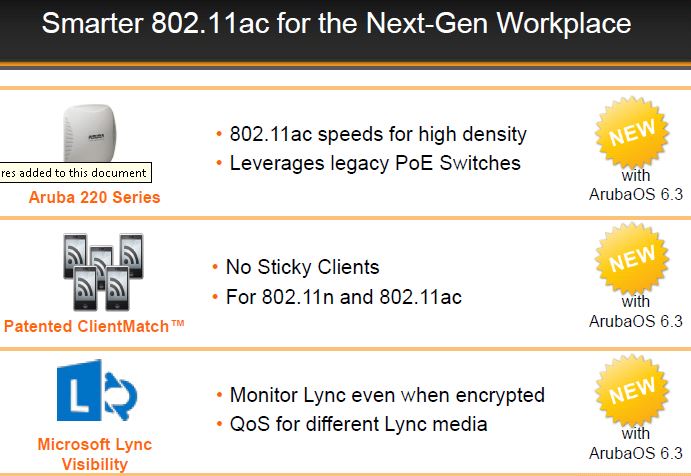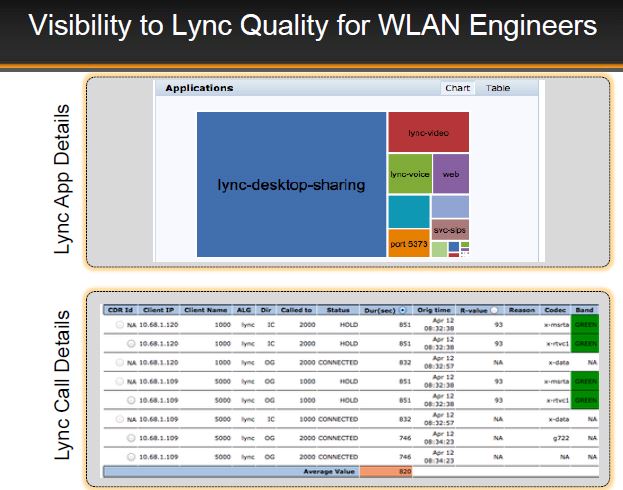It has become apparent as the relentless adoption of bring your own devices (BYODs) continues, that the workplace of the future, whether at a headquarters location or a remote site, will be wireless.
As more and more executives and company employees use their BYODs as their interaction platforms of choice, there are expectations regarding access, speed and security that must be met. Users want and need the kinds of performance of the wired world. Conversely, IT managers need to be able to deliver on those requirements and be able to monitor and analyze them as well to assure optimal results.
For this reason, enterprise wireless networking provider Aruba Networks’ introduction of its new flagship wireless LAN (WLAN) 802.11ac solution is one to watch. Aruba has introduced a solution that delivers gigabit Wi-Fi combined with the device density and application intelligence designed to meet the needs mentioned above.
Solving Important Challenges for the Wireless Workplace
It is no secret that enterprise IT departments are being overwhelmed by the proliferation of BYODs and other devices connecting to their networks. This creates challenges to provide high-performance bandwidth to every device as well as when there is a need to increase service in the number of devices in a given location. Complicating this is the additional problem IT administrators face in regards to what are known as “sticky” clients or devices—things that don’t automatically connect to and stay connected to the best access point. This results in slower speeds and inconsistent and unreliable connections.
There are also the challenges posed by business critical applications like real-time unified communications and collaboration (UCC). While these create the value when they have anywhere and all the time access, they also are often encrypted and can’t be identified by Wi-Fi networks. This makes it almost impossible to provide visibility or higher quality of service.
For those not familiar with the 802.11ac standard being implemented here. It was designed to deliver greater speed and capacity than its predecessor Wi-Fi networks. However, as Aruba points out, without a way to optimize how devices and clients connect to the Wi-Fi network, “an 802.11ac-based network will perform no differently than an 802.11n network.” Aruba’s 802.11ac solution is architected to solve these density, performance and reliability issues.
As Keyur Shah, senior product marketing manager, Aruba Networks told MobilityTechzone, “When the 802.11ac clients come out users will want a high-performance solution. The goal is to get rid of the desk phone, by giving users an experience that is compelling, while providing IT the tools to assure those experiences are always optimal.” He added that, “BYOD is driving this and there is no turning back on the fact that the workplace of will be wireless. Aruba’s goal is to make this seamless for the user and easily manageable for IT.”
A look under the hood of Aruba 220 Series Access Points (APs) and ClientMatch
The visual below is a quick illustration of the solution

Image via Aruba Networks
Highlights of each include:
Aruba 220 Series Access Points (APs)
The new APsare purpose-built for 802.11ac. They are more power efficient than modular 802.11ac APs. In fact, they feature a power-efficient mode with power over Ethernet (PoE) as the electricity source, and are designed to give enterprises the option to delay replacing their existing switch infrastructure and avoid the expensive labor costs associated with closet upgrades during WLAN design and deployment.
Specs include:
- 3x3:3 Dual Radio
- 5GHz 11ac: up to 1.3Gbps
- 2.4GHz 11n: up to 450Mbps (600Mbps with Broadcom clients)
- 2x GE link aggregation
- Enabling >1Gbps TCP throughput
- Operates with 802.3af, requires 802.3at for full functionality
The 220 Series supports higher density devices, solving the capacity issues confronting enterprise IT. They are smaller than other 802.11ac access points, and utilize two radios, rather than three, making them less expensive.
Patented ClientMatch Technology Resolves “Sticky Client” Issue
Aruba’s patented ClientMatch technology resolves the issue of “sticky clients” on 802.11ac and 802.11n Wi-Fi networks. This is a situation where mobile devices have difficulty connecting to the best possible access point. “Sticky client” problems occur due to a mobile device’s poor roaming algorithms, lack of proper RF interference monitoring, and competition with other slower devices that monopolize an entire channel. ClientMatch dynamically optimizes Wi-Fi client performance by putting the Wi-Fi infrastructure in control of client connection and roaming decisions. The end result is assurance that a device is always connected to the best performing AP.
In competitive testing, an Aruba WLAN with ClientMatch delivered up to 94 percent better device performance than that of a leading competitor. And, the company estimates that as a result of the combined capability it can reduce IT costs by as much as 76 percent.
Visibility into Voice, Video and UC Applications like Microsoft Lync for Improved App Performance
Aruba’s WLAN solution enables improved management of real-time UCC applications such as Microsoft Lync.

Image via Aruba Networks
Since these applications are often encrypted, traditional Wi-Fi networks cannot distinguish and therefore prioritize latency-sensitive media streams such as voice, video and desktop sharing over less sensitive data and file sharing streams. Aruba WLANs extract call quality data from Microsoft’s new Lync Diagnostics API and combine it with network status data. They monitor a variety of conditions that can compromise performance. It gives IT managers priority handling, end-to-end call visibility, faster root-cause fault identification, and hence the ability to provide a better overall user experience.
“UCC managers need end-to-end visibility into call performance so any issues that impact quality can be rapidly isolated to root cause,” commented Jamie Stark, Microsoft’s Lync product marketing manager. “Working with real-time, session-level metrics generated by Microsoft’s recently announced Lync Diagnostics API, as well as network data pulled directly from its Wi-Fi infrastructure, Aruba helps pinpoint the source of communication issues that impact Lync performance. The solution provides visibility into over-the-wire and over-the-air Lync performance, and is intended to help IT staff better identify, isolate, and ultimately, remediate UCC issues regardless of source.”
Market ready
Pricing and availability are also part of the story:
- The Aruba 220 Series APs, which can be used with Aruba’s complete portfolio of mobility controllers, will be available in June 2013.
- A controller-less Aruba Instant version will be available in Q3 2013.
- 220 Series AP prices start at U.S. list $1,295.
- ClientMatch and Microsoft Lync Visibility are also available in June as part of the new ArubaOS 6.3 software.
- ClientMatch is available as a free software upgrade to existing Aruba customers with support contracts.
- Lync Visibility is integrated into the Policy Enforcement Firewall (PEF) Module, a software add-on to ArubaOS, and is also available at no charge to customers who have already purchased PEF and have support contracts.
We are just on the cusp of the move to the next generation of Wi-Fi with the adoption of 802.11ac solutions. As Aruba has correctly identified, this is not just about speeds and feeds. It is much more. It is also about improving the customer experience whenever they are connected via Wi-Fi to the corporate network by giving IT the tools and analytics they need to plan, implement and operate a network that is operationally efficient and always best performing regardless of what has become a very dynamic, mobile and fluid workplace.
Edited by
Jamie Epstein
 QUICK LINKS
QUICK LINKS